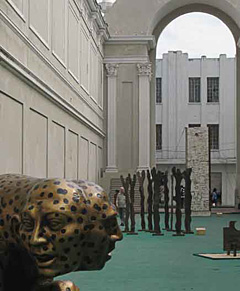
|
 |
 |
 Vallarta Living | Art Talk | February 2008 Vallarta Living | Art Talk | February 2008  
The History of the Progress of Humankind in the Yucatan
 Paul Hill - People's Weekly World Paul Hill - People's Weekly World
go to original


| | MACAY (Museo de Contemporaneo Ateneo de Yucatan) | | |
Merida, Mexico – Why is it that wherever you travel you can trace the footprints of the progress of mankind? I recently visited Merida, Mexico and found great monuments to progressive struggles and leaders everywhere.

On the beautiful Paseo de Montejo, which has been compared to the Champs-Elysees in Paris, France, there is an impressive monument to Felipe Carrillo Puerto who was the socialist Governor of the Mexican state of Yucatan from 1922 to 1924. He fought for land reform, women’s suffrage, and rights for the indigenous Mayan people. He was assassinated in Merida in January 1924 by his reactionary opponents. When he was brutally killed, three of his brothers and eight of their friends were killed with him. Several towns in Mexico have been named in his honor.

I viewed the works of an internationally recognized muralist, Fernando Castro Pacheco, in the Governor’s Palace and in the MACAY art museum. The mural in the MACAY museum was striking since it depicted the struggle of the Mayan people against their three major oppressors. The first part of the mural showed the struggle against Mayan emperors. The second part shows the struggle against the Spanish conquistadors. The third shows a worker impaled on the leaves of the Sisal plant symbolizing the exploitation of the Mayan farm workers by the plantation owners. Sisal is the plant which is used in the production of rope. At one point, Merida was reputed to have the largest concentration of wealthy people in the world due to the production of Sisal by the Mayan workers.

In the Governor’s Palace there are 26 murals which illustrate the history of the struggle of the people of Yucatan. Pacheco’s works are in the style of Diego Rivera and David Siqueiros.

The murals honor progressive leaders such as Friar Bartolomé de Las Casas, whose writings denounced the inhumane treatment of the Mayan people. One painting titled "Mexico’s Eternal Struggle" symbolizes the struggle between "Good" and "Evil." Good is represented by the eagle and evil by a serpent. In Mexican national symbols the eagle stands for the Mexican people and their positive qualities and the serpent symbolizes corruption, exploitation and poverty.

Another mural titled "Sale of Indians" shows the horrors of slavery which included the sale of warriors as well as women and children. President Benito Juarez prohibited slavery during his administration.

One mural titled "The Caste War" depicts a bloody struggle which lasted 50 years and cost 300,000 lives. The struggle ended the domination by the conquistadors of the Mayan people. Another mural "The Triumph of the Republic" illustrates the struggle between the imperialists and Republicans in the city of Merida. Benito Juarez had the French oppressor, Maximilian, shot on the Hill of Bells at the culmination of the struggle. Manuel Cepeda Peraza lead the liberation of Merida from the imperialists which was completed on July 15, 1867.

Pacheco also memorializes Bishop Juan Gómez de Parada. He led the fight for restoration of rights for the Mayan people exploited by colonial society. He courageously issued an edict on October 6, 1724 which prohibited obligatory personal service for the Indians and proclaimed their absolute freedom of labor, thus making them equal citizens. The landowners denounced him and arranged for his expulsion to Guatemala.

Salvador Alvarado is also memorialized in the Pacheco murals. He is considered "the one true liberator of the Mayan slaves." He was governor of Yucatan from 1915 to 1918. He introduced ideas of social emancipation and passed several laws favoring peasants, education and women.

The mural "Agrarian reform" consists of portraits of Felipe Carrillo Puerto (mentioned earlier in this article) and Lázaro Cardenas. They were major figures in the emancipation of the Mayan peasants. Cardenas, at the national level, was responsible for the expropriation of the oil industry and agrarian land distribution. However, it was Puerto who first carried out land distribution among Mayan peasants. He also put into effect an advanced body of law benefiting the Yucatecan people.

So, you see, the answer to the question posed at the beginning of the article is that one can find evidence of the progress of mankind wherever you go because "the history of all hitherto existing society is the history of class struggles."

PHill1917(at)comcast.net | 
 | |
 |



